Affiliate links on Android Authority may earn us a commission. Learn more.
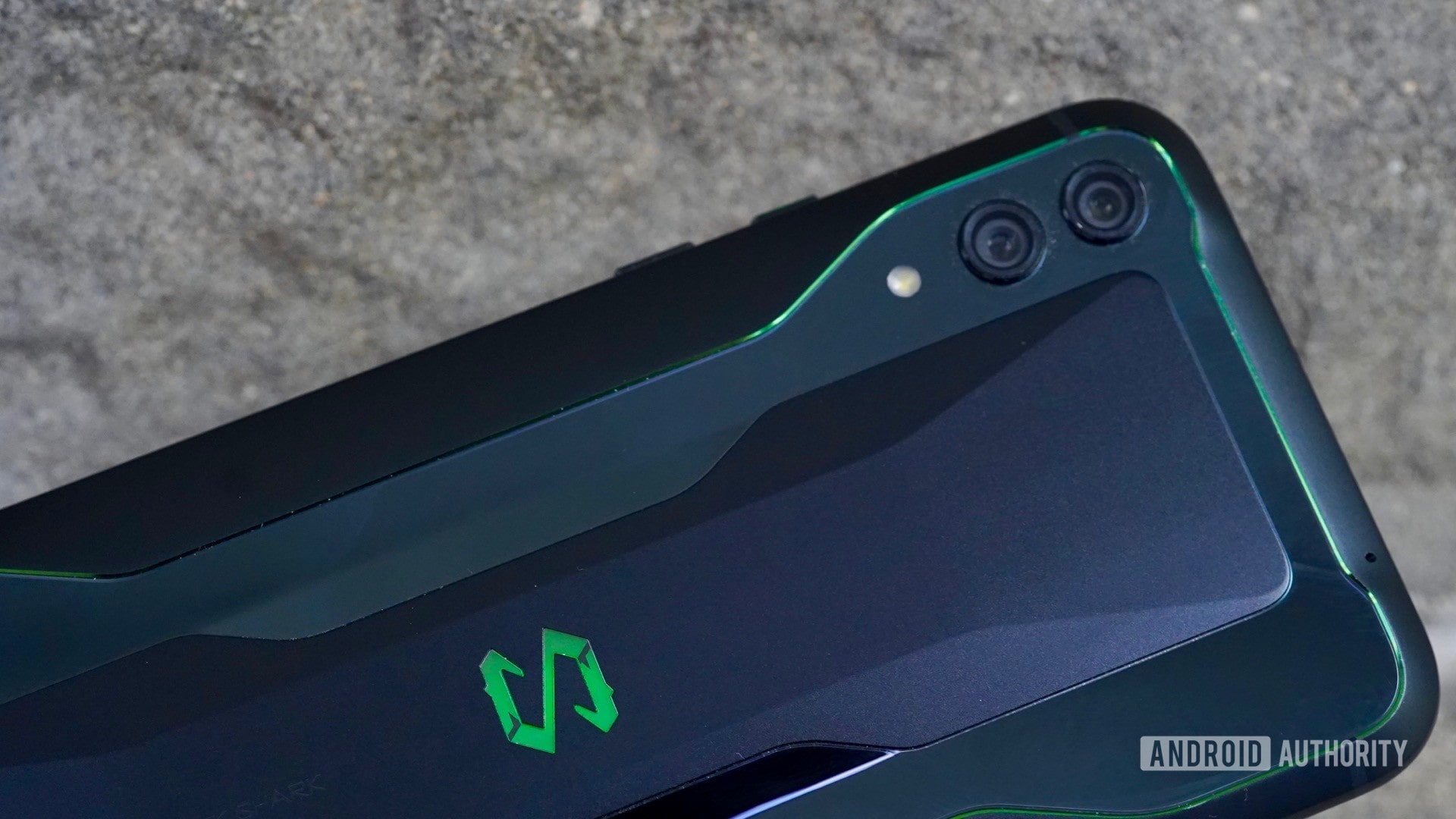
Black Shark 2 review: Taking another bite from gamers' wallets (Update: Now in India)
Published onMay 27, 2019
Black Shark Black Shark 2
What we like
What we don't like
Black Shark Black Shark 2
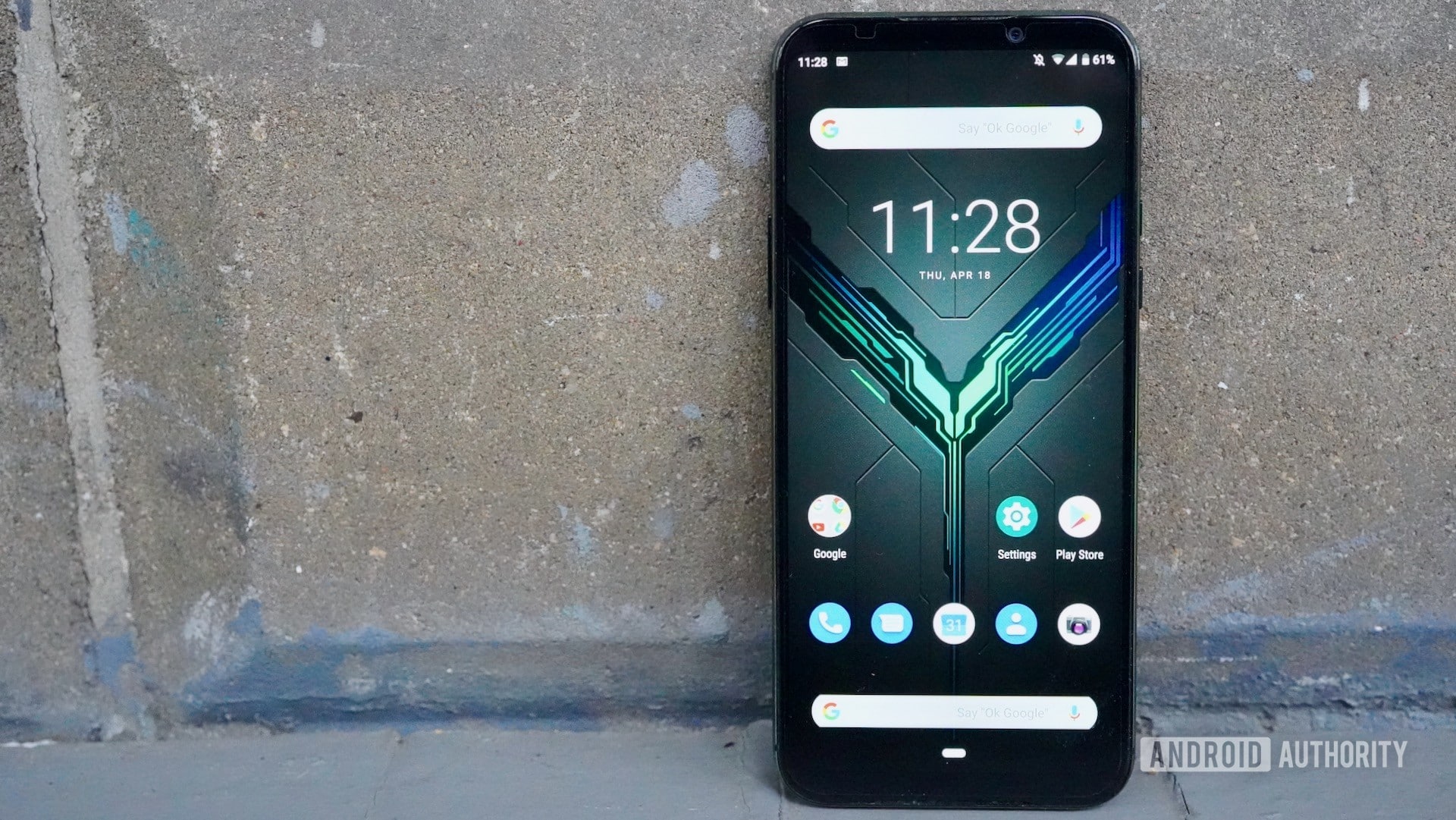
Ready for another shark attack? Black Shark has returned with a sequel to its 2018 gaming phone. The Black Shark 2 builds on the core of the original, adding modest improvements along the way. With a slick, light-aided design outside and drool-worthy silicon inside, the Black Shark 2 is ready to chomp through your favorite games and look good doing it.
Here is Android Authority‘s Black Shark 2 review.
Black Shark 2 review: The big picture
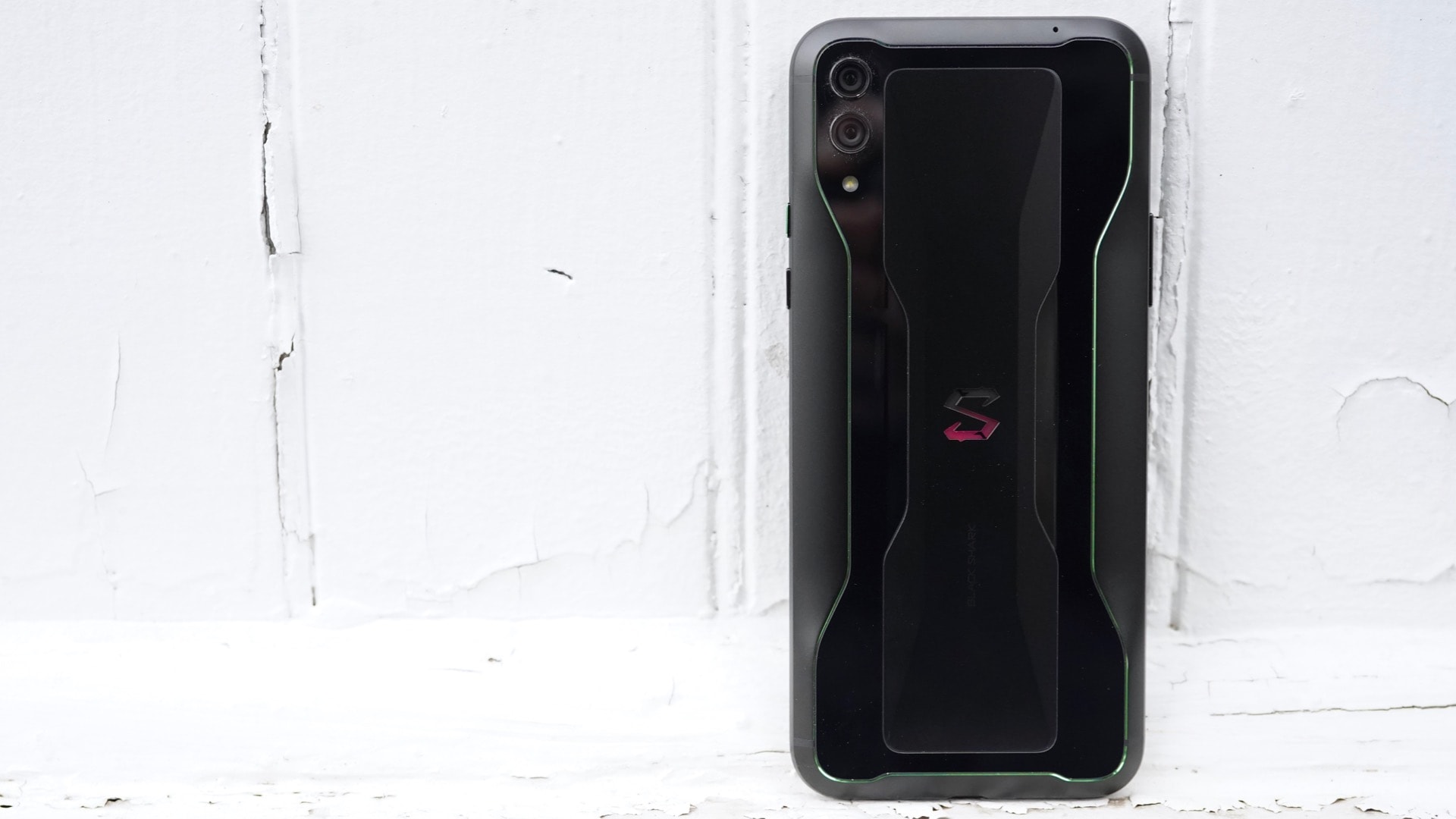
Gaming phones have really become a thing in the last few years. Razer has already pumped out two of them, ASUS has one, and Black Shark now has its second. They are meant to appeal to mobile gamers who demand top performance from their device so they can torment their foes on the go.
What often sets these devices apart are garish and overwrought designs, overclocked processors, advanced cooling systems, and the sweet promise of victory. Let’s not forget unconventional extras, such as game controllers, gamepad stands, and thermal vents. The Black Shark 2 and its ilk are not for the faint of heart.
The are some big caveats in this category. Gaming phones so far don’t seem to prioritize the “phone” part of the equation. Because of that, they aren’t necessarily the best option for casual gamers, let alone everyday users.
What’s in the box
- Black Shark 2
- Charger
- USB-C cable
- Slim case
The Black Shark 2 does not come with any cool gaming accessories, like a controller. That stuff all costs extra. Box contents are limited to the absolute basics. I’d even say Black Shark skimps out a bit: Not only are there no headphones, but there’s no headphone adapter, either. Black Shark’s USB-C headphones are an optional purchase (and shouldn’t be).
I will say one thing about the case: It has two small ledges onto which you can latch your fingertips. The grippy material of the case and these ledges really help you take firm hold of the phone when gaming.
Design
- Gaming lights
- 163.6mm x 75mm x 8.77mm, 208g
- Sturdy aluminum chassis
- USB-C
- Shadow Black / Frozen Silver colors
Typically, there is nothing subtle about gaming hardware. For many, the very thought of dedicated gaming gear conjures up images of jet-black devices with red, orange, or green backlit keyboards that practically glow in the dark. The Black Shark 2 fits this stereotype to a T.
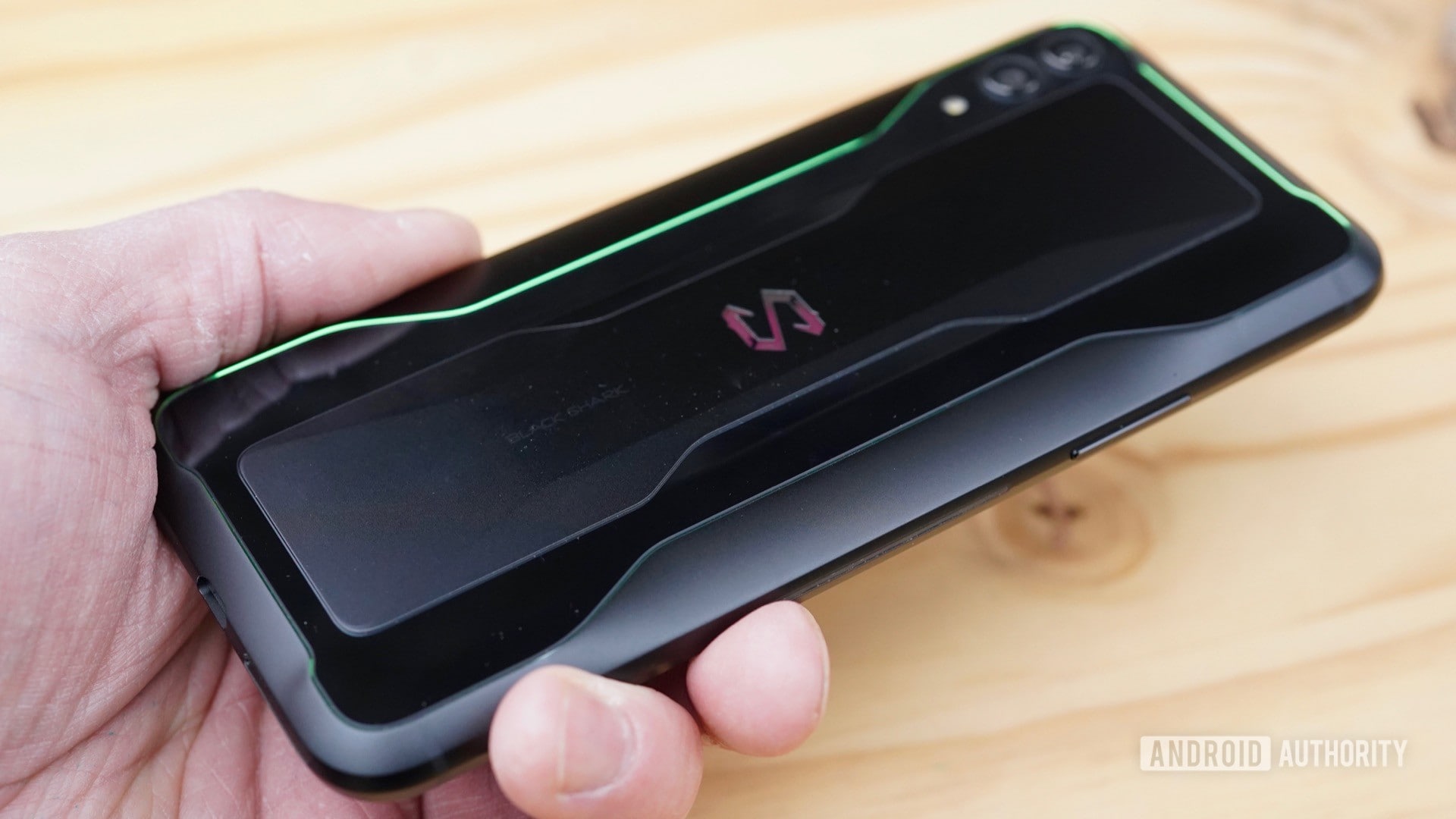
The Black Shark 2 is (surprise, surprise) black with green accents. From the front it almost looks like a regular slab, but the green chamfer on the metal frame gives it away. This accent glints in the light as you move the phone around. The color is akin to that of the Wicked Witch of the West. I don’t dislike it.
The stereo speakers are hidden fairly well. Black Shark cut small slivers from the front glass where it meets the frame on the top and bottom edges, and crammed them into these crevices.
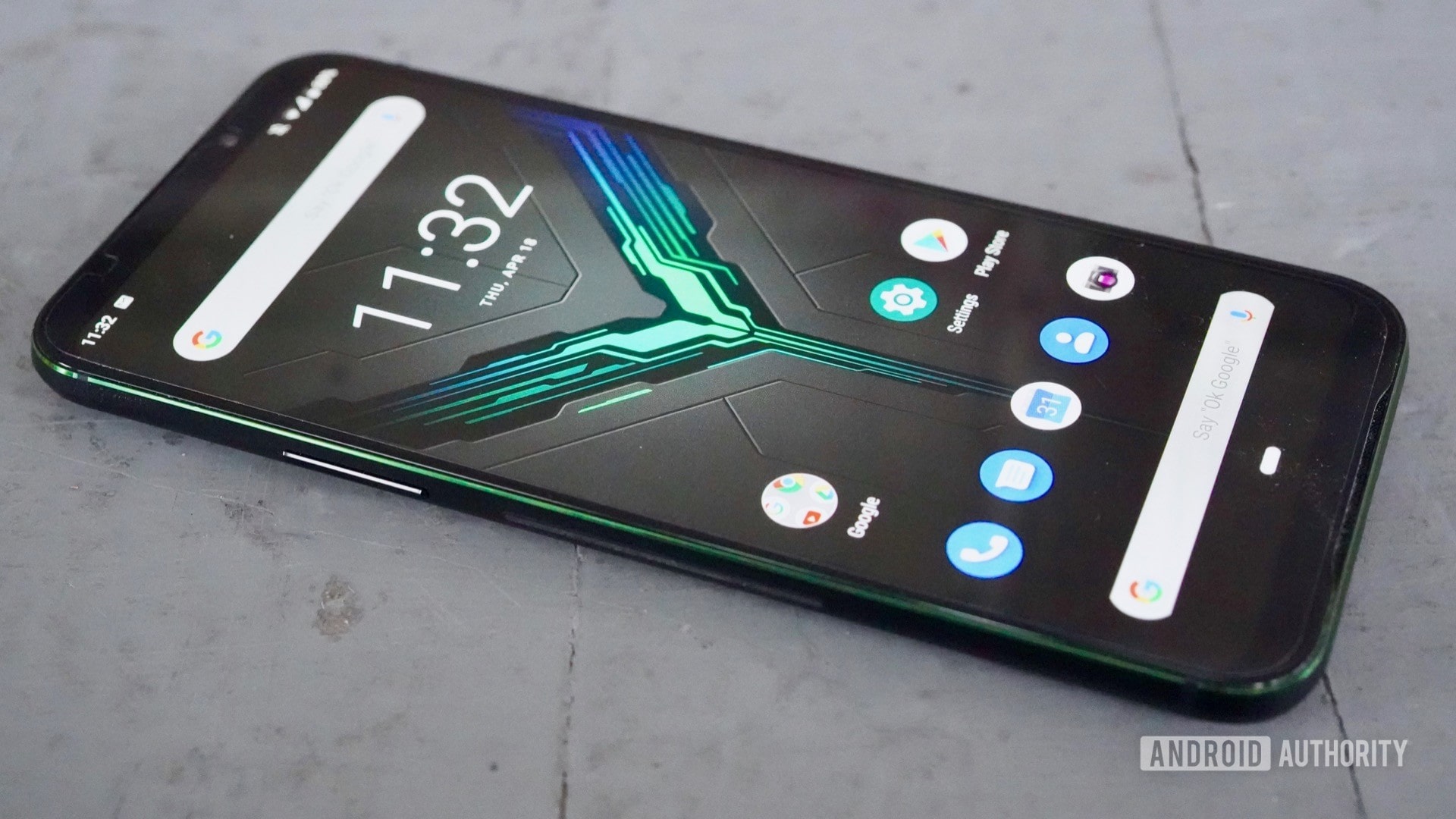
Where the front of the phone is all glass, the rest of the chassis is some seriously heavy metal. The side edges and rear are a single aluminum piece, broken up with a glass inset with green seams. The design is incredibly busy and chaotic, but I think that’s the point. This phone would look at home aboard a Romulan Warbird.
The glass inset is highly reflective, which contrasts with the matte black paint on the metal. Black Shark says it also helps with cooling and signal performance.
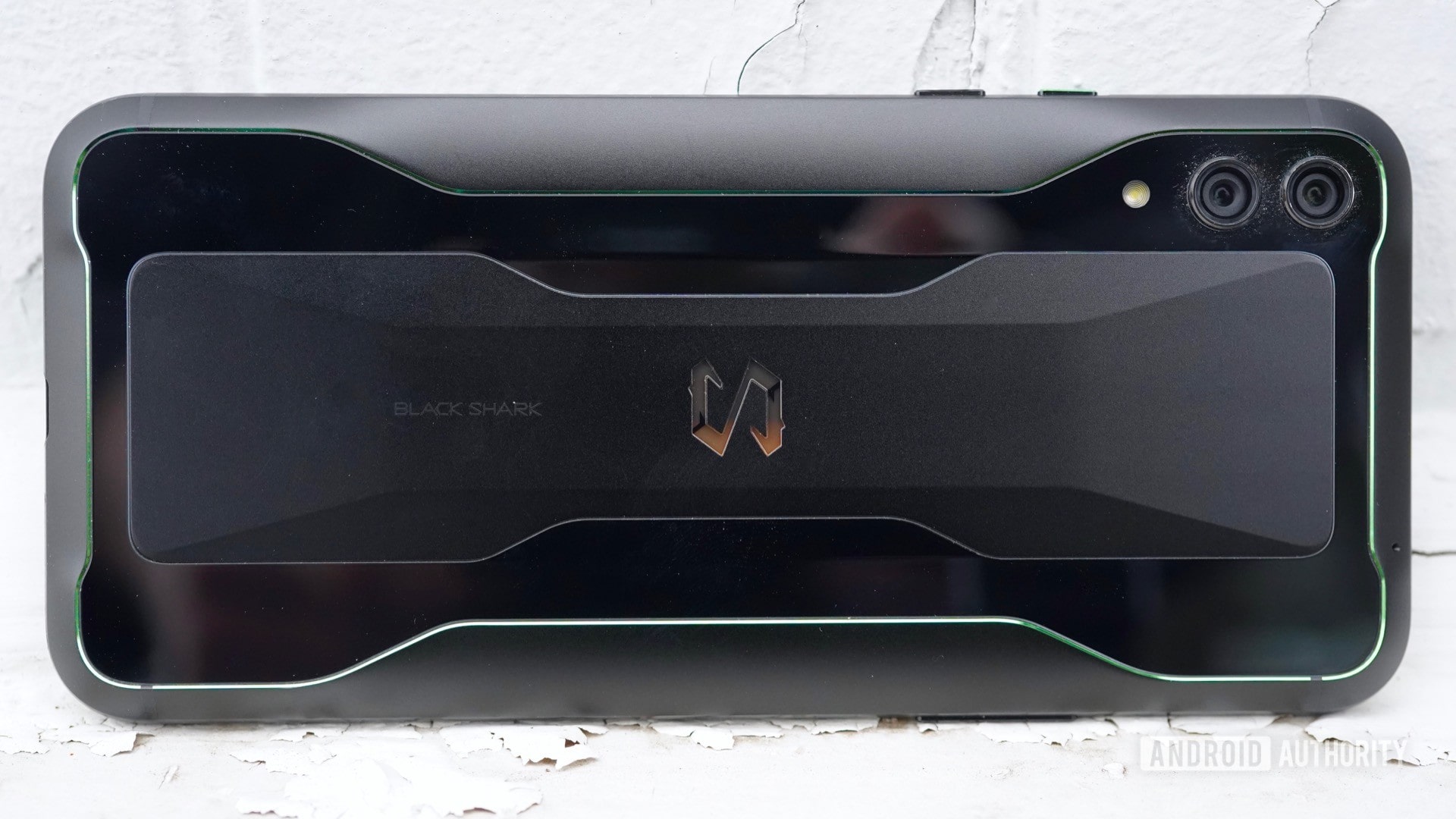
Then there are the lights. The Black Shark logo is positioned dead center on the rear of the phone and, just like the rear logos of the ROG Phone and Razer Phone 2, can be customized to glow and pulse in just about any color (16.8 million, says Black Shark). The light-up logo is joined by two illuminated strips on the side edges called light belts. The default color for the strips is the same green used to accentuate the metal frame, but the belts can also glow and pulse in a wide range of colors and patterns.
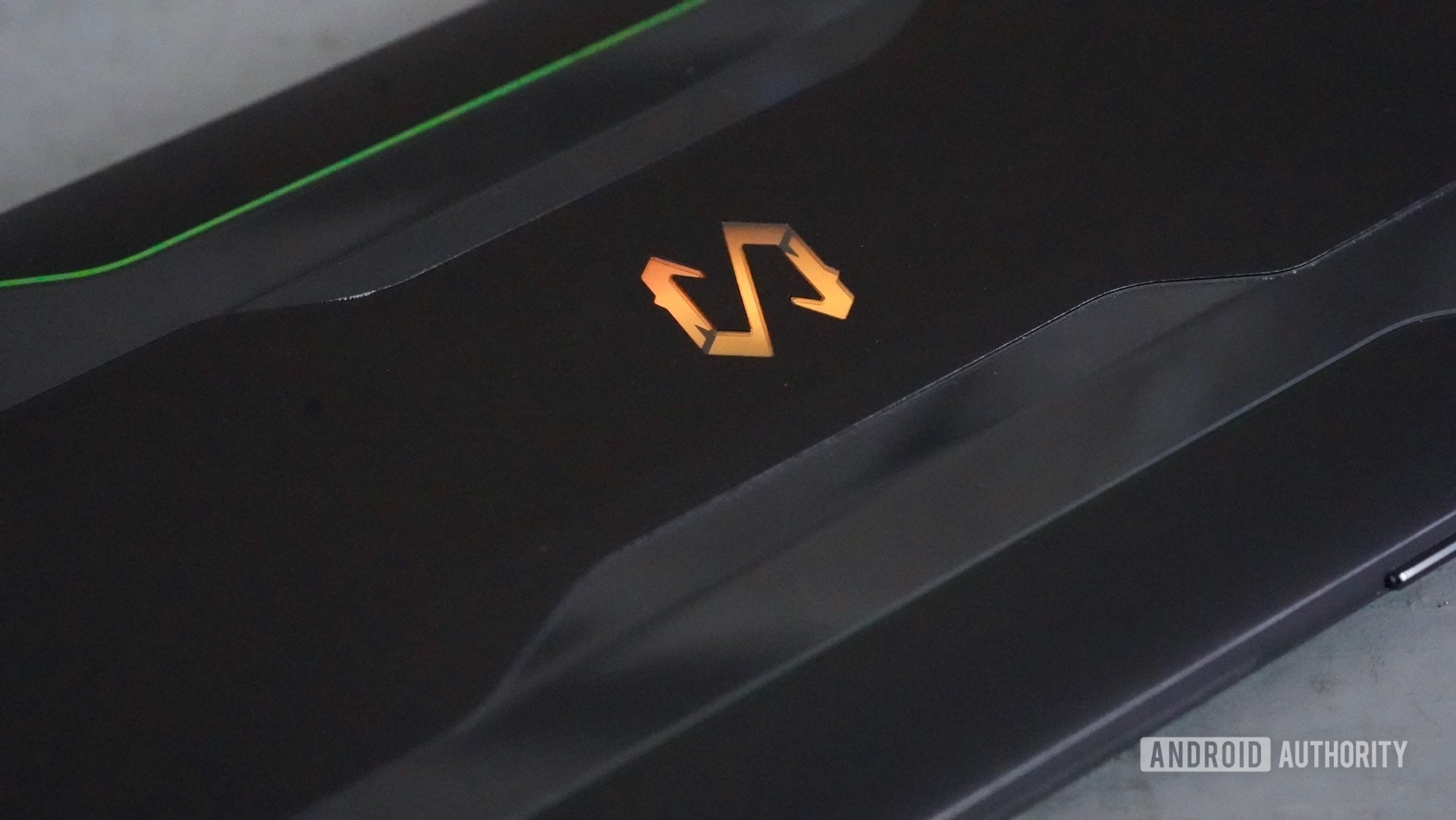
Black Shark calls all this “sports car design 3.0.” Maybe you see things differently than I do, but nothing about this phone looks like a sports car to me. The Black Shark 2 is a wholly modern device, and unashamedly so.
The chassis is some seriously heavy metal.
It’s also huge and heavy. The amount of metal used in the chassis really adds up. This phone isn’t the most comfortable thing to hold for an extended time. It also tugs at your pants when you walk around with it in your pocket. If size and weight matter to you at all, the Black Shark 2 is likely more than you can handle.
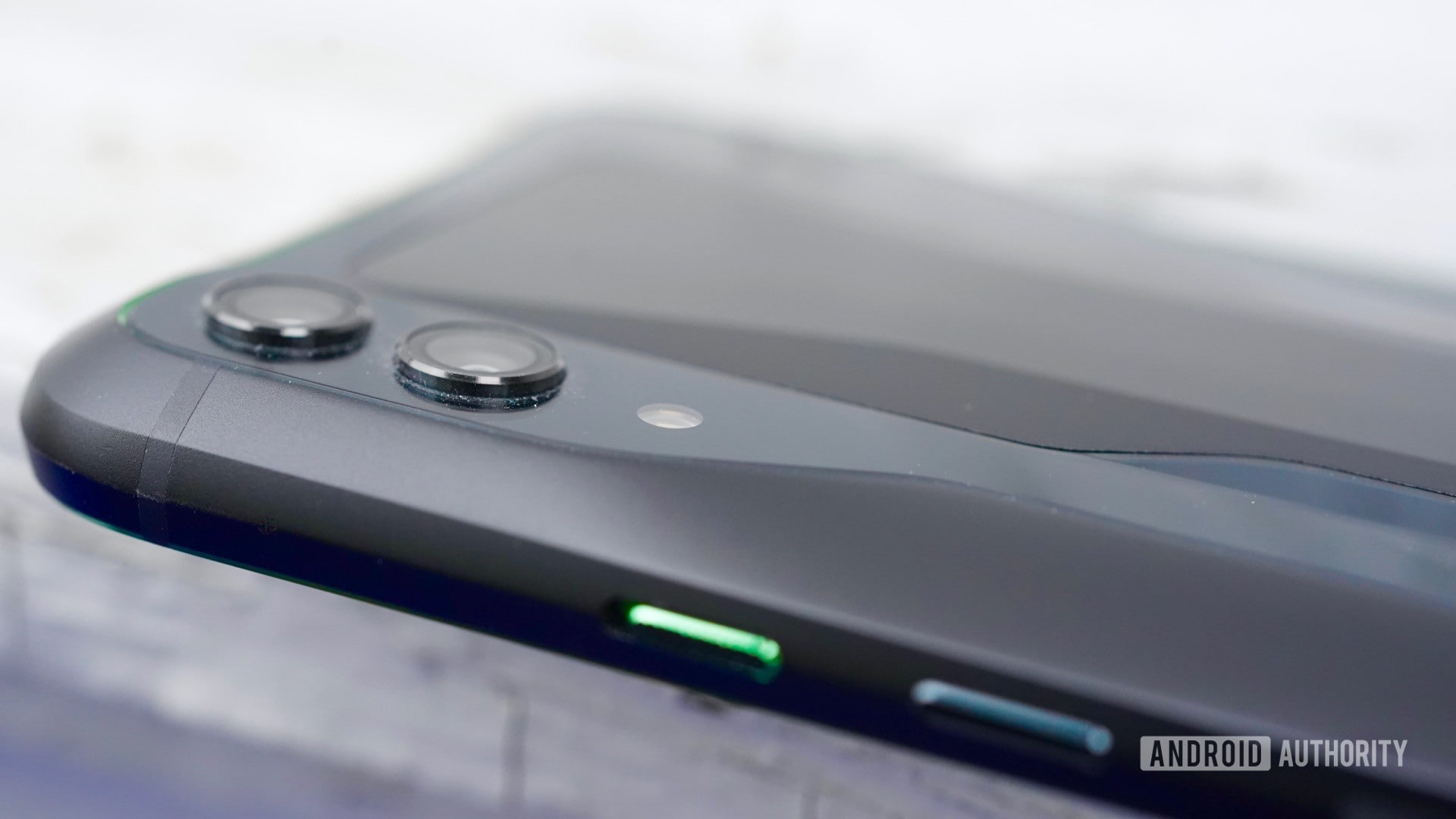
The controls generally work as they should. A short volume toggle is perched high up on the left side, while the small power and screen button and dedicated Shark Key are on the right. The buttons have excellent profiles and perfect action.
You’ll find a USB-C port on the bottom, but no headphone jack. (The ROG Phone has one, the Razer Phone 2 does not). The SIM tray is tucked into the bottom, too, and the phone supports up to two SIM cards but not a memory card.
Like many modern phones, the dual camera array is pushed into the top left corner of the rear panel. Each round module stands out on its own, rather significantly if you ask me.
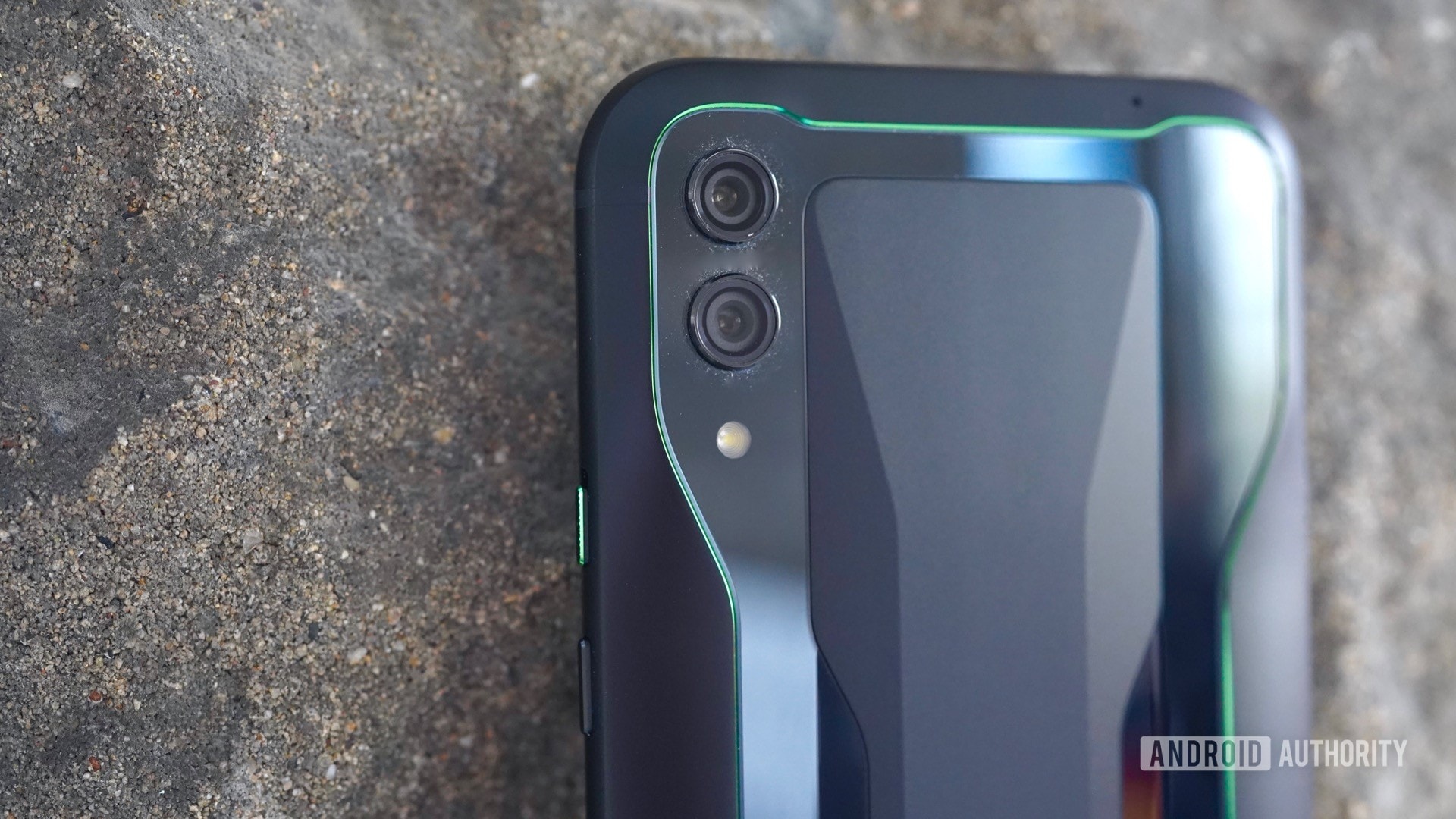
There’s no waterproofing or even water resistance for this phone, and, despite the metal build, it isn’t truly rugged.
The Black Shark 2 is an aggressive-looking piece of hardware, and it may be too much for some people. It’s not the sort of phone I’d gravitate toward myself, but I’m glad companies are experimenting with design in devices such as this and other gaming phones.
Display
- 6.39-inch Full HD+ AMOLED
- 2,340 by 1,080 resolution, 430ppi
- 19.5:9 aspect ratio
- 430-nit brightness
Black Shark gave the display a significant update on its second outing. Where the original phone had a 5.99-inch LCD panel, the Black Shark 2 has a larger OLED display. This is a huge improvement.
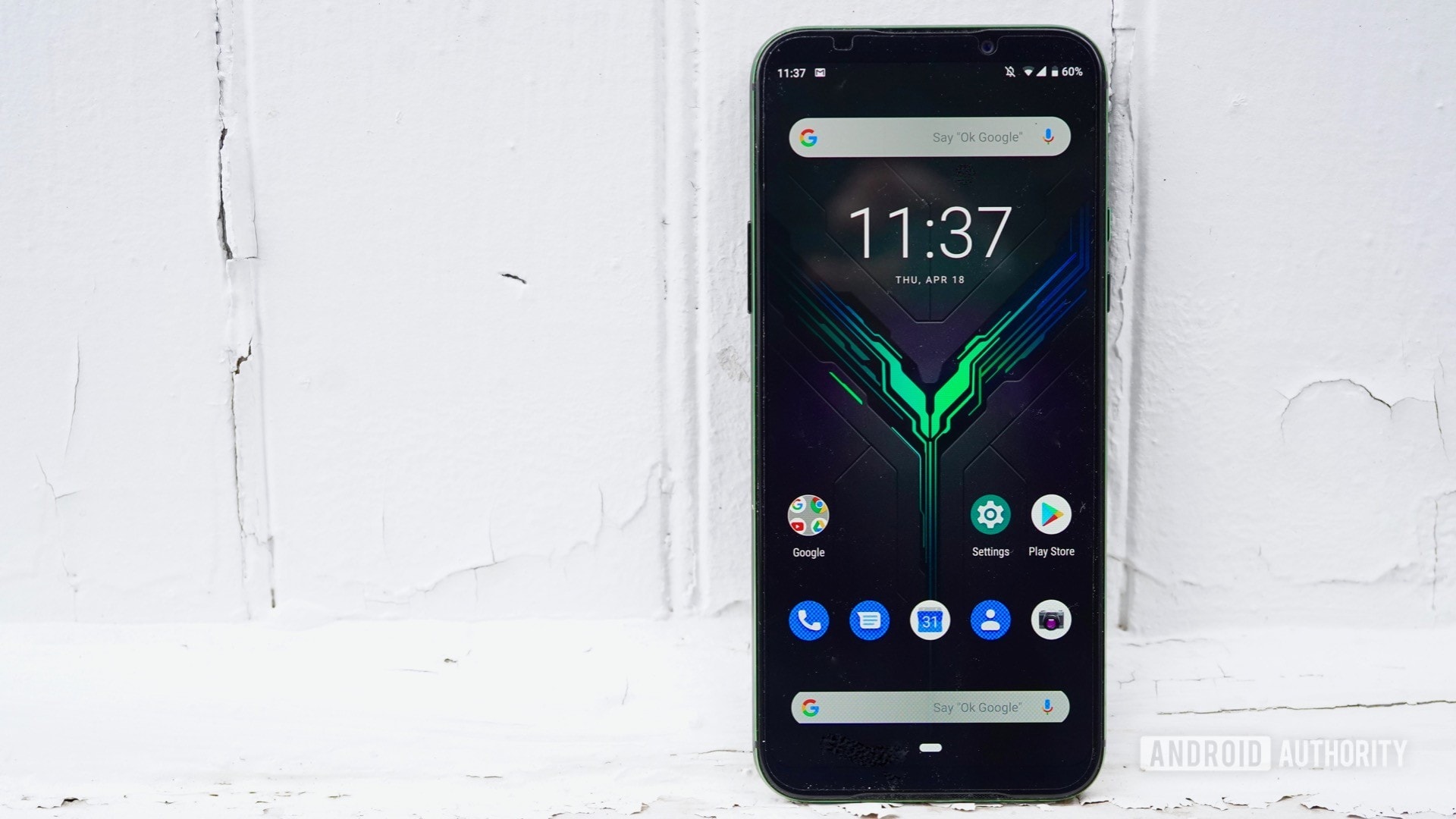
At a basic level, the resolution is the same at Full HD+. Given the number of games optimized for 1080p resolution, this is right where it should be. Everything looks crisp and sharp on the phone. The OLED panel produces far more contrast than the older LCD, and this boosts blacks and colors. The result is a richer visual experience when gaming and watching Netflix.
Black Shark says it made improvements in color accuracy, which was a complaint with the original. Whites look much more true, with only the slightest tinge of yellow. Viewing angles are great, and there’s no blue shift.
The phone doesn't quite pump out enough light
Brightness is the biggest bummer as far as I am concerned. The 430-nit brightness rating is great on paper, but the reality isn’t quite as impressive. You’ll have no issues gaming in your dark bedroom or basement, but using the camera or Google Maps outdoors is problematic. The phone doesn’t quite pump out enough light for easy outdoor performance. It’s not disastrous, but it could be better.
As expected, you can adjust the color temperature, set blue light filters, and make other adjustments to the screen to suit your individual preferences.
The display is also where you’ll find the fingerprint sensor. Yes, it’s embedded under the front glass. I didn’t run into any snafus training the sensor, but it only worked about half the time. As much as I like the animation that blasts up the screen when you use the fingerprint sensor, it’s just too unreliable for me.
The fingerprint sensor works only about half the time. That's just too unreliable.
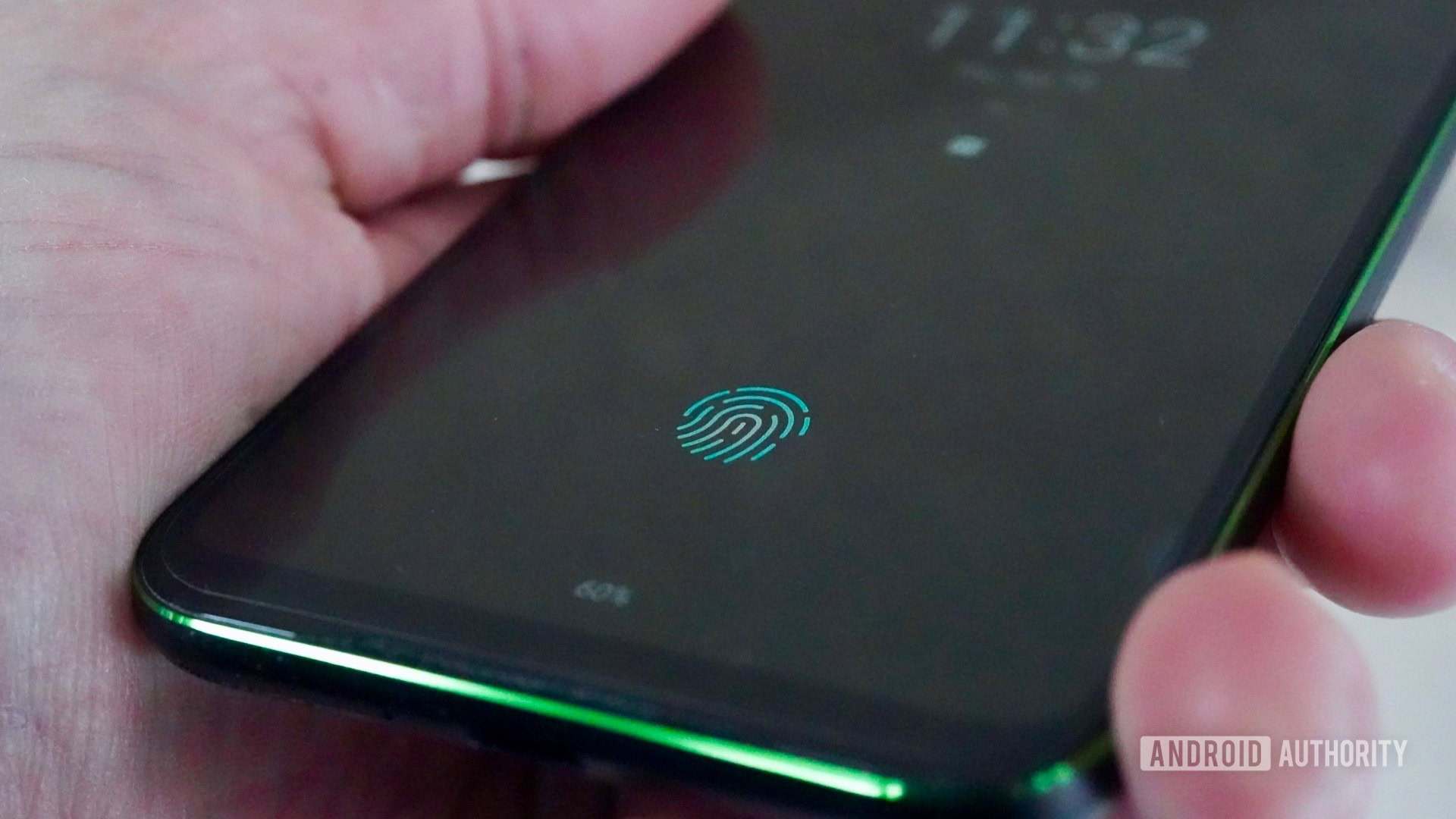
The Black Shark 2 also supports camera-based Face Unlock. It’s faster and more convenient than the fingerprint reader, but not as secure. I resorted to using a PIN.
Performance
- Snapdragon 855 S0C
- 2.8GHz octa-core, 7nm process
- 8 or 12GB of RAM
- 128 or 256GB of storage
- Liquid Cooling
With one of the top chips available and a healthy allotment of RAM, the Black Shark 2 roared through benchmarks — those we could install anyway. 3DMark installed and ran normally, but AnTuTu and GeekBench did not. We substituted in 3D Bench and ran that simply to have another point of comparison.
On 3DMark, the phone generated a 5,566 on Sling Shot Extreme OpenGL ES 3.1 and 4,909 on Vulkan. It rated better than 99 percent of all phones in the database.
The scores don’t matter that much because the phone just screams. The Black Shark 2 conquered every task, every app, and every game set before it. It rendered smooth 3D landscapes and delivered blistering gameplay. PUBG and Fortnite ran as well on the Black Shark 2 as they did on the ROG Phone and flagship phones, such as the Samsung Galaxy S10.
The phone has a number of performance-enhancing capabilities. For starters, it is liquid cooled and has a multi-layered heat dissipation system meant to move thermal energy away from the processor cores. This includes a heat-conducting copper shield and a multi-layer graphite film. The phone did not get overly hot during gameplay.
The Black Shark 2 does not support U.S. LTE bands. I tried both AT&T and T-Mobile SIM cards and came up with basic GSM service in some areas and spotty 3G in others. This device is intended for the U.K., EU, India, and China.
Battery
- 4,000mAh Lithium-ion
- Qualcomm Quick Charge 4.0 (27W)
The phone absolutely crushes it in battery life. If you simply want a phone with killer battery performance, the Black Shark 2 is a fine place to look. It breezed through 48 hours and beyond with plenty of power to spare.
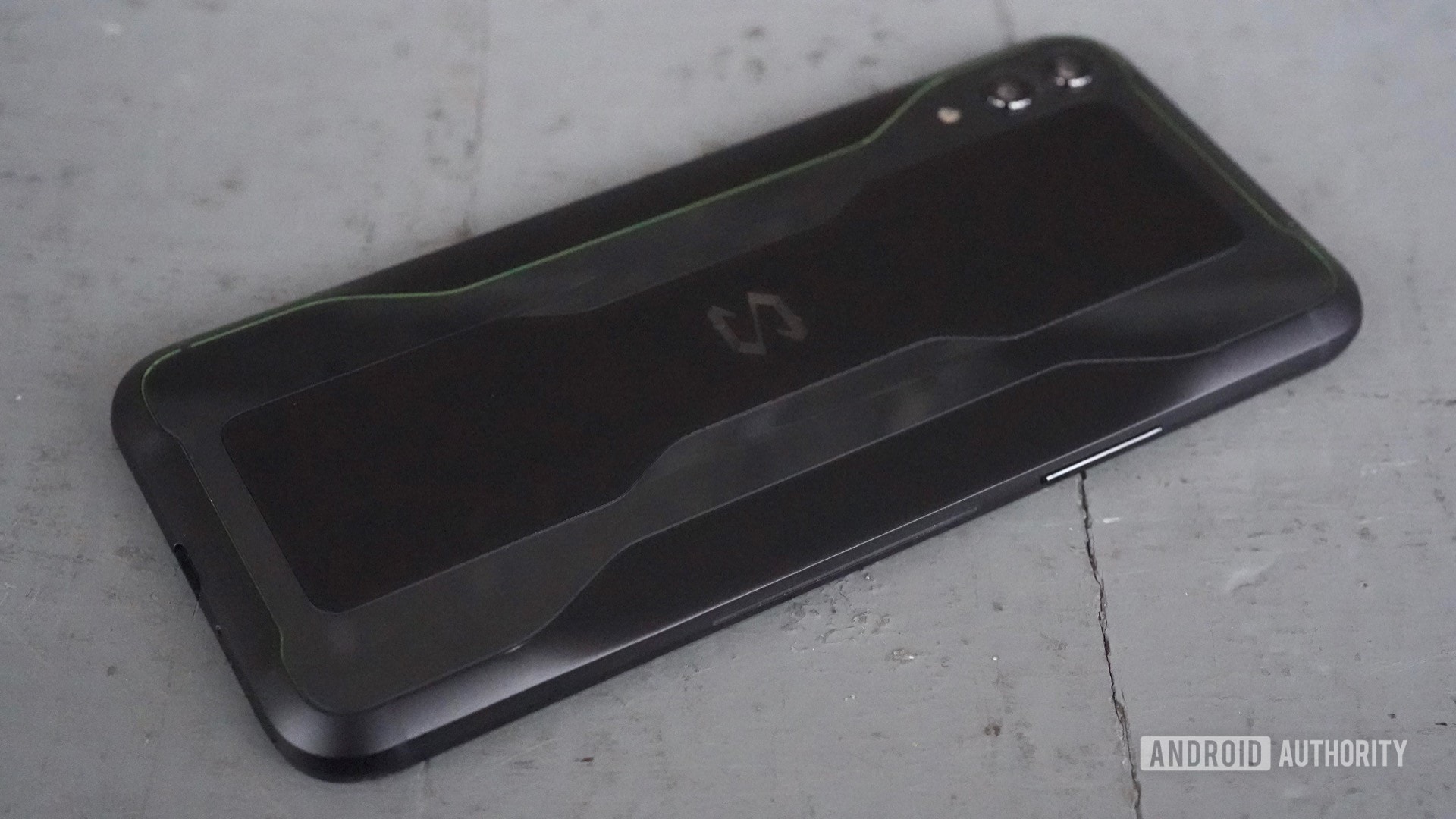
If you’re going to spend a lot of time gaming, expect a little more than one day of battery life. The processor may be fine-tuned and super-cooled, but pushing polygons is taxing work. Playing Fortnite or Asphalt for more than an hour or two took a noticeable toll on the battery. Rest assured, you can spend several hours gaming each day and still push from morning to night with a bit of breathing room.
Engrossed in an epic campaign and can’t put the phone down? No need to worry. The Black Shark supports Qualcomm Quick Charge 4.0 (27W). Thirty minutes plugged into the included charger will provide a whopping 60 percent boost in battery life (it’ll take you from 10 percent to 70 percent). Yeah, it charges rapidly. Really rapidly.
There’s no wireless charging aboard, but the speedy wired power-ups make up for it as far as I am concerned.
Camera
- Rear cameras:
- 48MP primary sensor, f/1.75 aperture
- 12MP 2x telephoto sensor, f/2.2 aperture
- Front camera:
- 20MP sensor, f/2.0 aperture
The Black Shark 2’s camera matches competing devices’ features, though not necessarily their quality. The dual-camera setup on the rear lets you shoot normal and telephoto images, as well as use the two lenses together for portrait/bokeh. This is standard fare for a modern device.
The controls for the app tread industry norms. A viewfinder fills the middle of the screen, while several controls line one edge and shutter buttons line the other. Modes are available thanks to a ribbon running alongside the shutter button. They include short video, slow motion, video, photo, portrait, square, panorama, and pro (manual). The pro mode allows you to take control over white balance, focus, shutter speed, ISO, and which lens you’re using. You select modes by tapping the name or swiping the whole viewfinder back and forth. Thankfully this action is quick and smooth.
I dig that quick controls let you manage the flash, HDR, AI cam, and filters with your left thumb. There are even rudimentary tilt shift, beauty, and straightener tools. The full settings menu allows you to tweak the rest of the camera’s ins and outs.
In terms of photo quality, the Black Shark 2 does slightly better than average. I was expecting disastrous results and came away pleasantly surprised.
The majority of photos showed sharp focus. I was particularly pleased with the cuckoo clock shot, which was taken in fairly low light. It is sharp and mostly free of noise. You will see come compression artifacts here and there, but it isn’t too terrible.

Dynamic scenes presented trouble for the camera. The shot of the bridge running across the river with the waterfall in the foreground lacks detail in the dark iron of the bridge. You can see similar problems in some of the other river shots. Only a couple of photos came out overexposed.

White balance was a problem. You can see a deep yellow tint to the rock wall image. Color accuracy was inconsistent across the board.
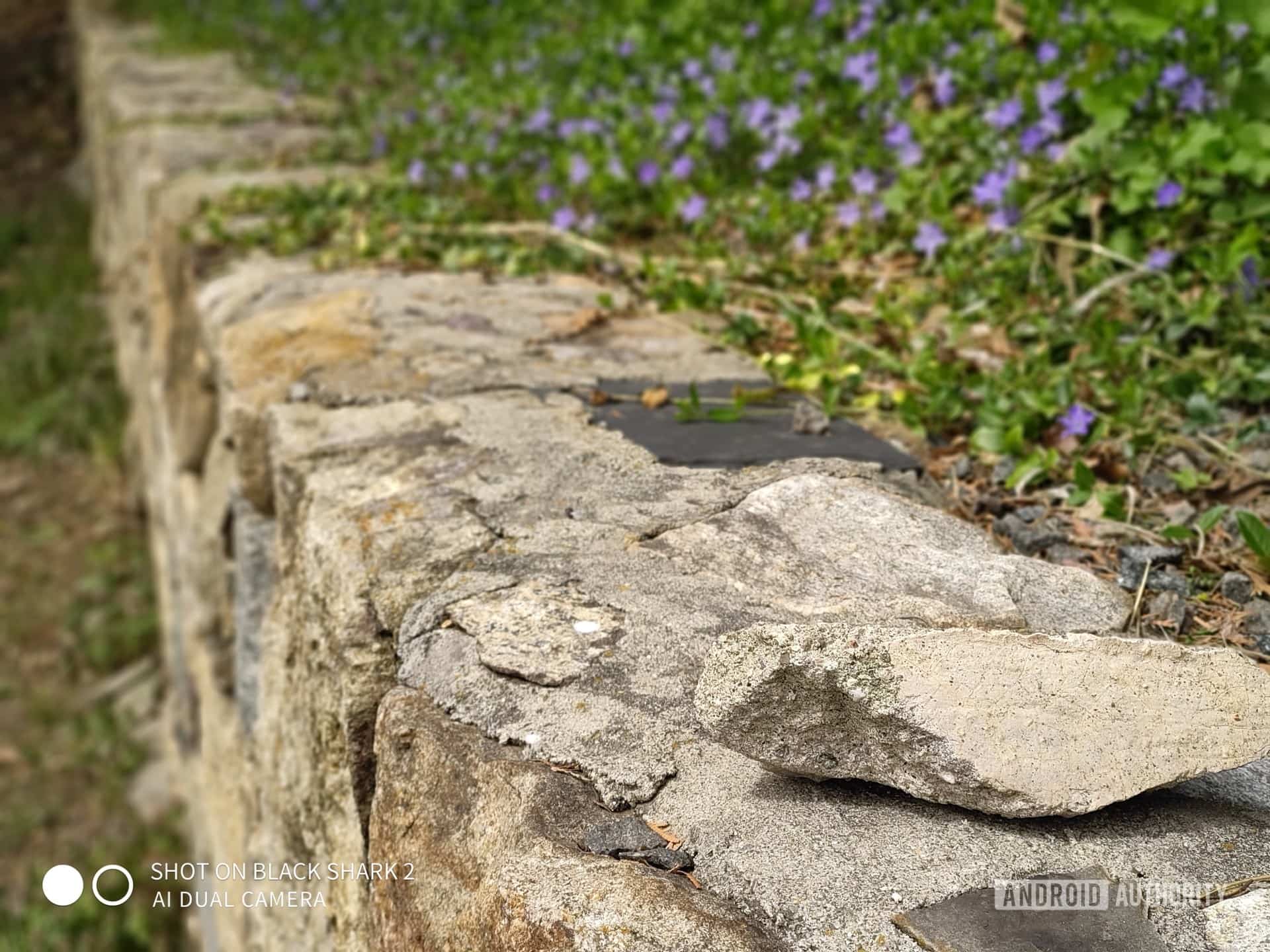
The portrait shots do okay, but edge detection was not perfect. The selfie camera did a decent job with normal selfies. You can see good focus on me and a slight blur to the rock wall behind me. The whole shot leans a bit toward yellow, though, and could have more detail.
You can shoot video up to 4K. The samples I captured looked clean, well exposed, and mostly free of noise.
You can find a gallery of full-resolution photo samples here.
Audio
- USB-C audio
- Bluetooth 5 with aptX HD
- Stereo speakers
The audio experience is more of a mixed bag than I was expecting. Stereo speakers are a good starting point, but the lack of 3.5mm headphone jack and USB-C audio gear in the box mean you’re your own for headphones.
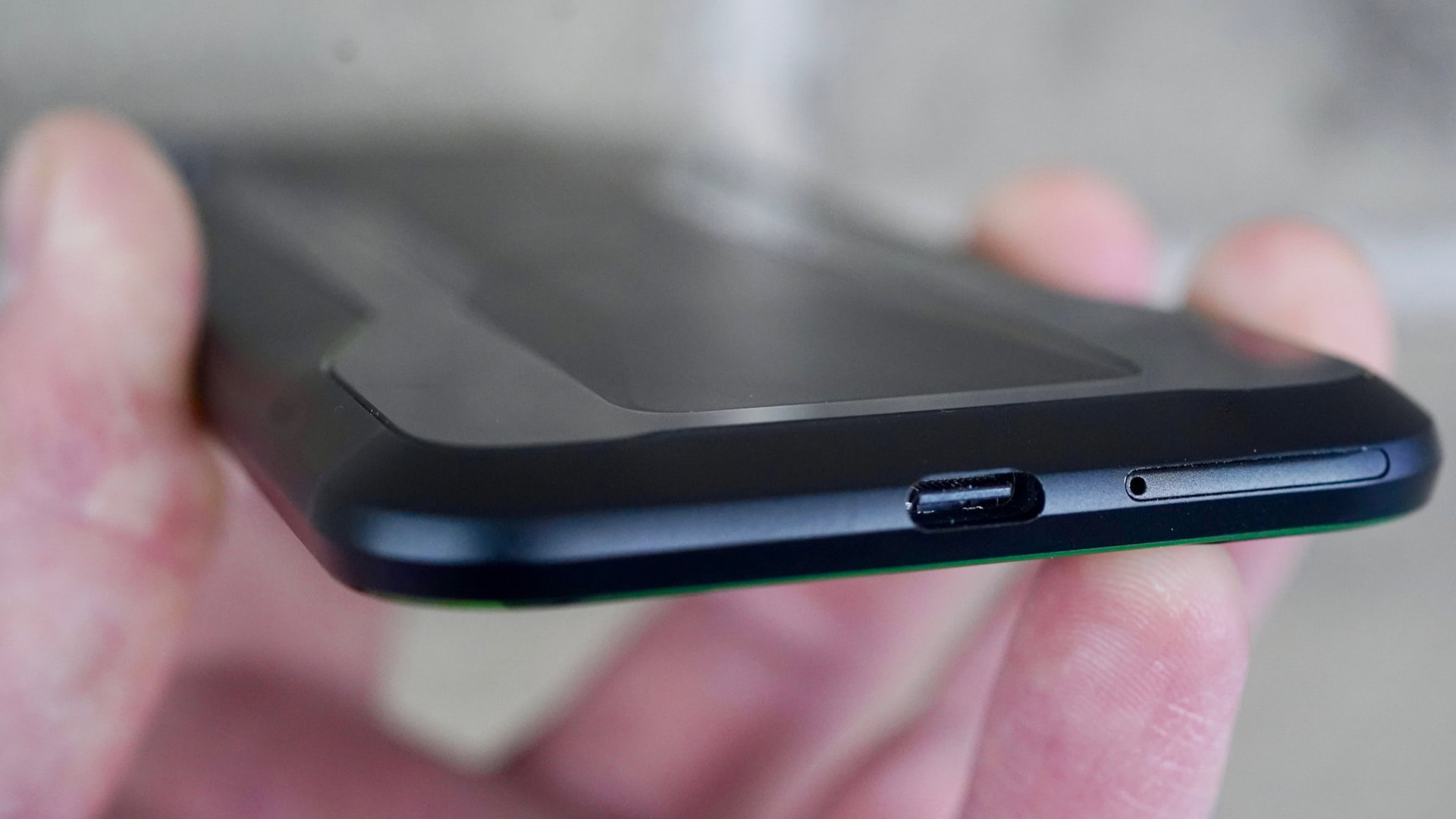
I'm disappointed with the lack of control over audio.
The speakers can deliver 1W of audio output, which means the Black Shark 2 can get really loud. The company upped the output of the right speaker by about 25 percent to make up for the fact that it will likely be covered by your grip when gaming. Moreover, it will adjust automatically to balance the volume if it detects it is covered.
Volume isn’t everything. Games generally sound good via the speakers, but music sounds boomy in a bad way. The same is true of video content from YouTube and Netflix. I would prefer much crisper highs and tighter lows. Flagships like the Galaxy S10 and LG G8, and gaming phones like the ASUS ROG Phone, have a better stereo speaker experience. The sounds from PUBG were about what I expected from an FPS, and the screeching tires in Asphalt seemed authentic.
Using a USB-C-to-3.5mm adapter I had on hand, I patched my best pair of wired headphones into the Black Shark 2. What I heard sounded good.
I was much happier, however, to listen via my favorite Bluetooth headphones. With support for aptX HD on board, you’re in for a treat if you have compatible headphones.
If you’re a serious gamer, you likely own a dedicated set of gaming headphones with a mic. Speaking of mics, there is a dedicated gaming mic on one side of the phone to ensure it isn’t covered by your hand while you play.
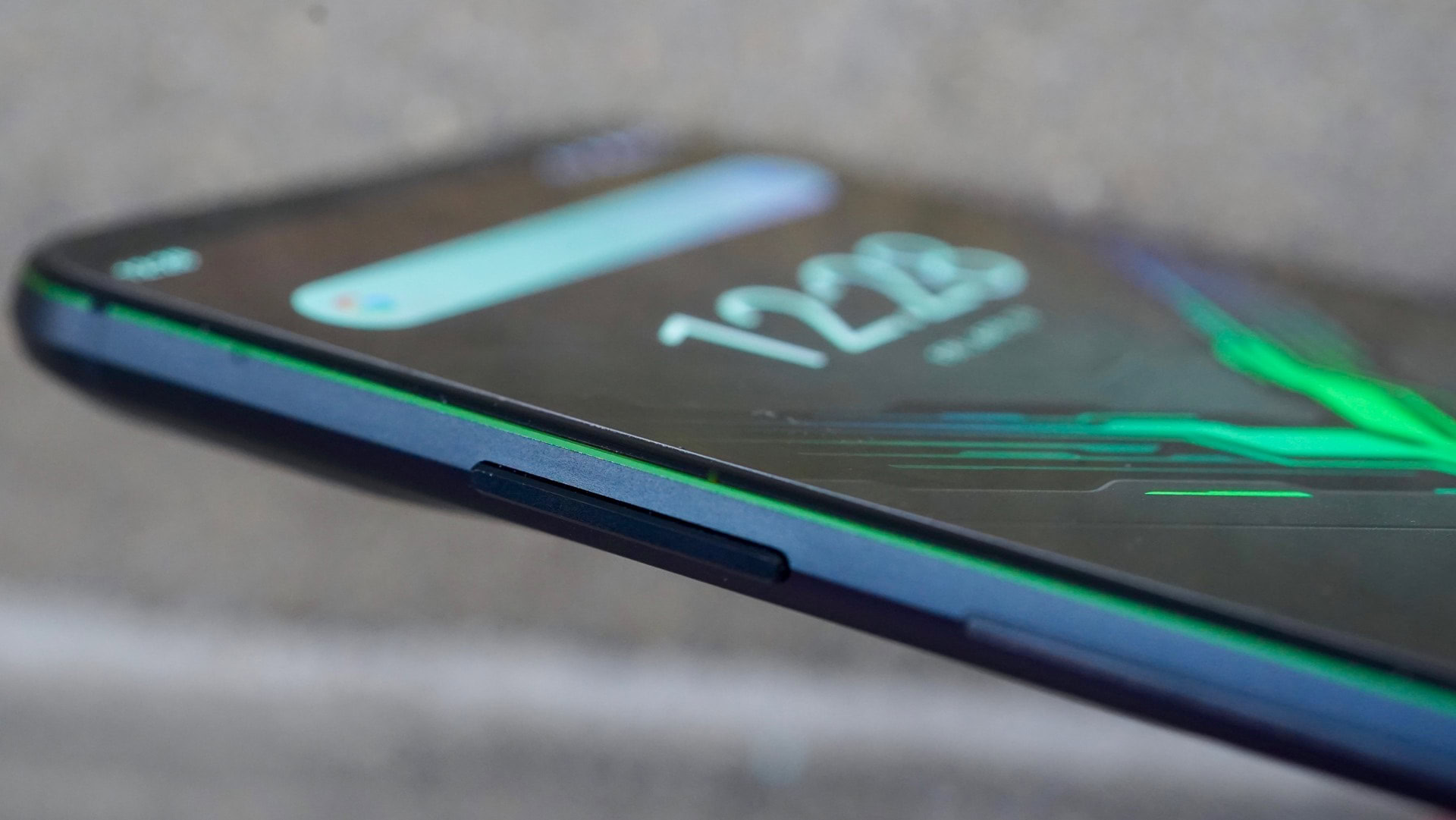
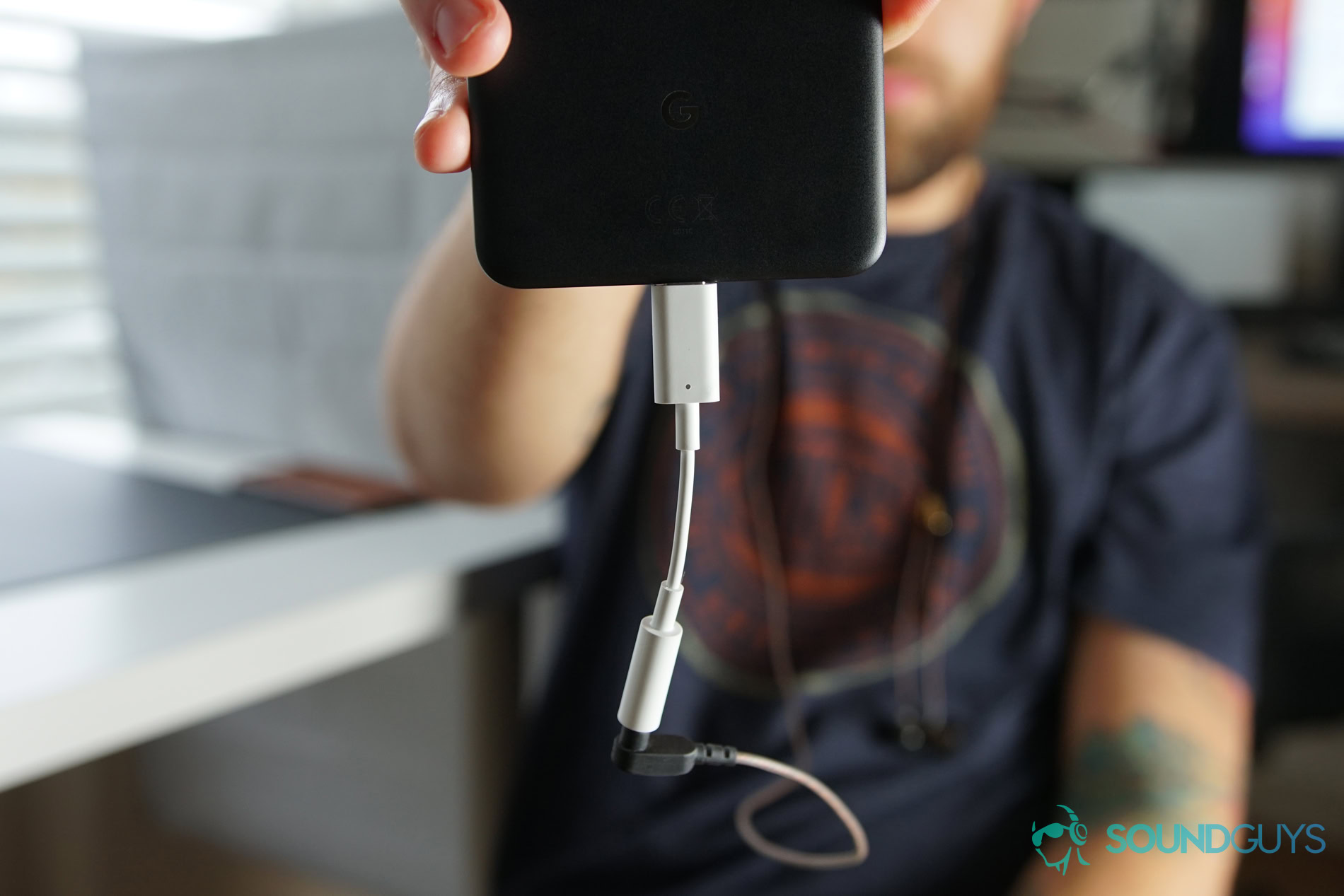
I am really disappointed with the lack of control over the sound. The phone provides you with only the most basic tools for tweaking in-game volume, equalizer settings, and such. I was expecting a bit more.
Software
- Android 9 Pie
We tested the international version of the Black Shark 2, which has a slightly different software experience than the Chinese and Indian versions. It runs vanilla Android out of the box. In fact, I wouldn’t blame you if you didn’t realize the phone has a gaming focus at all — at least based on the software.
Really the only clues you have are the “Game Dock” and “Light Settings” found at the bottom of the settings menu. These two let you adjust certain aspects of the gaming experience, such as notifications, frame rates, brightness, and the floating window that acts as a dashboard for all your key performance metrics (battery temp, CPU temp, CPU frequency, and so on).
The Shark Key on the right side grants entry to the phone’s gaming zone, called Shark Space. It’s quite something. The first thing Shark Space lets you know is this mode squashes notifications and will essentially help you focus 100 percent on gaming. It also dumps out the RAM to help boost speeds.
Shark Space is essentially a central location for all your games. Any titles you download from the Play Store are automatically loaded into the Shark Space launcher. They are arranged in a carousel you swipe through side-to-side to select the game you wish to play. Like the phone itself, the loader is black with green accents.
You’ll also find controls for the optional gaming pads. If you purchase the pads you can customize the actions for each button here, as well as perform some baseline calibrations.
If you don’t have the controllers, you can map on-screen buttons to perform specific tasks. Moreover, the display is capable of 240Hz touch sensitivity with latency as low as 43.5ms. Together, these translate to faster finger recognition and quicker response to your input (and, hopefully, quicker kills in the game).
One thing Shark Space doesn’t let you do is manage the phone’s performance. On the ROG Phone, the gaming dashboard gives you insight into the battery and processor health and status. Moreover, ASUS lets you tweak some aspects to improve performance or prevent the phone from sucking too much battery life while playing games. While the Game Dock lets you assess the Black Shark 2’s CPU cycles and temperature, there are no controls in Shark Space for actually managing any of it.
Black Shark 2 specs
| Black Shark 2 | |
|---|---|
Display | 6.39-inch AMOLED Full HD+ (2,340 x 1,080) 19.5:9 aspect ratio 430ppi 430nit brightness |
Processor | Qualcomm Snapdragon 855 SoC, 2.84GHz Adreno 640 GPU |
Memory and Storage | 8GB RAM / 128GB storage 12GB RAM / 256GB storage LDDR4X, dual channel, 2133MHZ |
Camera | Rear: Main 12MP f/1.75 LED flash PDAF Secondary: 12MP f2.2 with 2x optical zoom Front camera: 20MP f/2.0 0.9 μm pixels AI beauty mode Timer Portrait |
Video | 4k @ 30fps 1080p @ 30fps 720p @ 30fps Slow motion: 720p @ 240fps and 1080p @ 120fps |
Size | 163.6mm x 75mm x 8.77mm 208g |
Sensors | Gravity Ambient light Proximity Gyroscope Magnetometer Fingerprint reader Force Touch |
Connectivity | FDD LTE (B1, B3,B4,B5,B7,B8,B20,B28) TDD LTE (B34, B38,B39,B40,B41) 4x4 MIMO 3XCA and 2XCA TD-SCDMA (B34, B39) WCDMA (B1, B2,B5,B8) GSM (B2,B3B5,B8) CDMA/EVDO (BCO) Wi-Fi 5 (dual channel, 2x2 MIMO 802.11a/b/g/n/ac Bluetooth 5.0 GPS AGPP GLONASS BEIDOU |
Audio | Stereo speakers USB-C audio Bluetooth aptX HD |
Value for the money
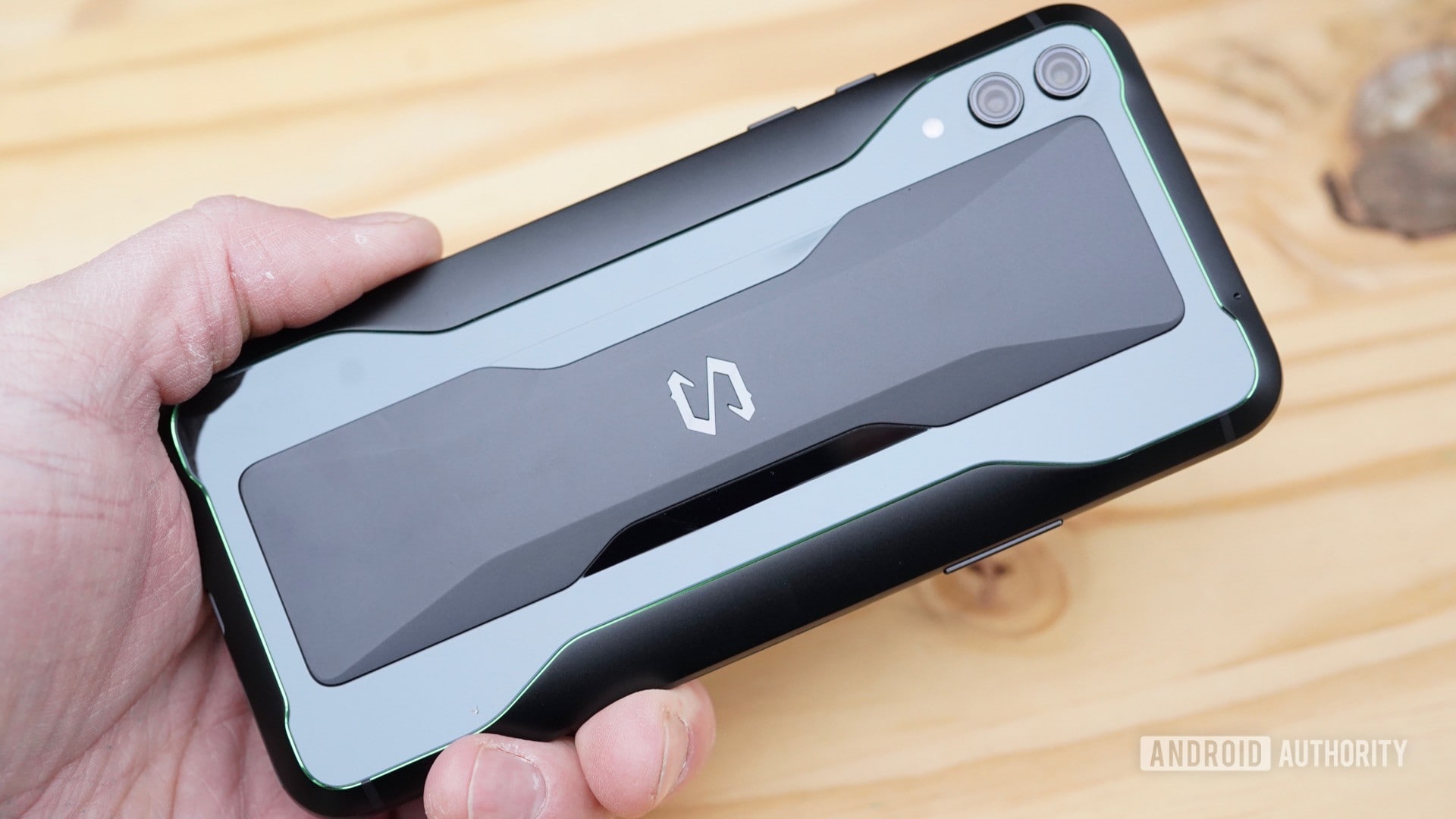
The Black Shark 2 is available now in the U.K. and the EU. The 8GB RAM and 128GB storage variant costs 470 pounds or 549 euros, respectively, which equates to about $625. The higher-spec’d version is not yet available.
The phone launches in India on June 4, 2019 and is priced at 39,999 rupees (~$575) for the 6GB RAM and 128GB storage variant. You can step up to the 12GB RAM and 256GB variant for 49,999 rupees (~$720). The phone will be sold exclusively on Flipkart.
Black Shark does not plan to sell the device in the U.S. directly and, given the lack of support for U.S. wireless networks, I wouldn’t recommend it to U.S. buyers.
The Black Shark 2 is a solid value for the money spent.
The price isn’t bad, all things considered. You get a solid piece of hardware with a good display, outrageous battery life, and some of the fastest performance I’ve seen from a phone. The camera is surprisingly decent, and the hardware has more personality that any slab you might buy at your local carrier shop. The phone runs a clean version of Android, and the gaming lights can be a lot of fun.
In comparison, the ASUS ROG Phone still runs a steep $899 (before accessories), while the Razer Phone 2 has been discounted to $499. That means the Black Shark 2 threads the needle here. I think you’re getting more phone in the Black Shark than the Razer, but the ROG Phone is the best of these three. Bottom line, I’d call the Black Shark 2, at 479 pounds or 549 euros a fair price and solid value for the money spent.
Black Shark 2 review: The verdict
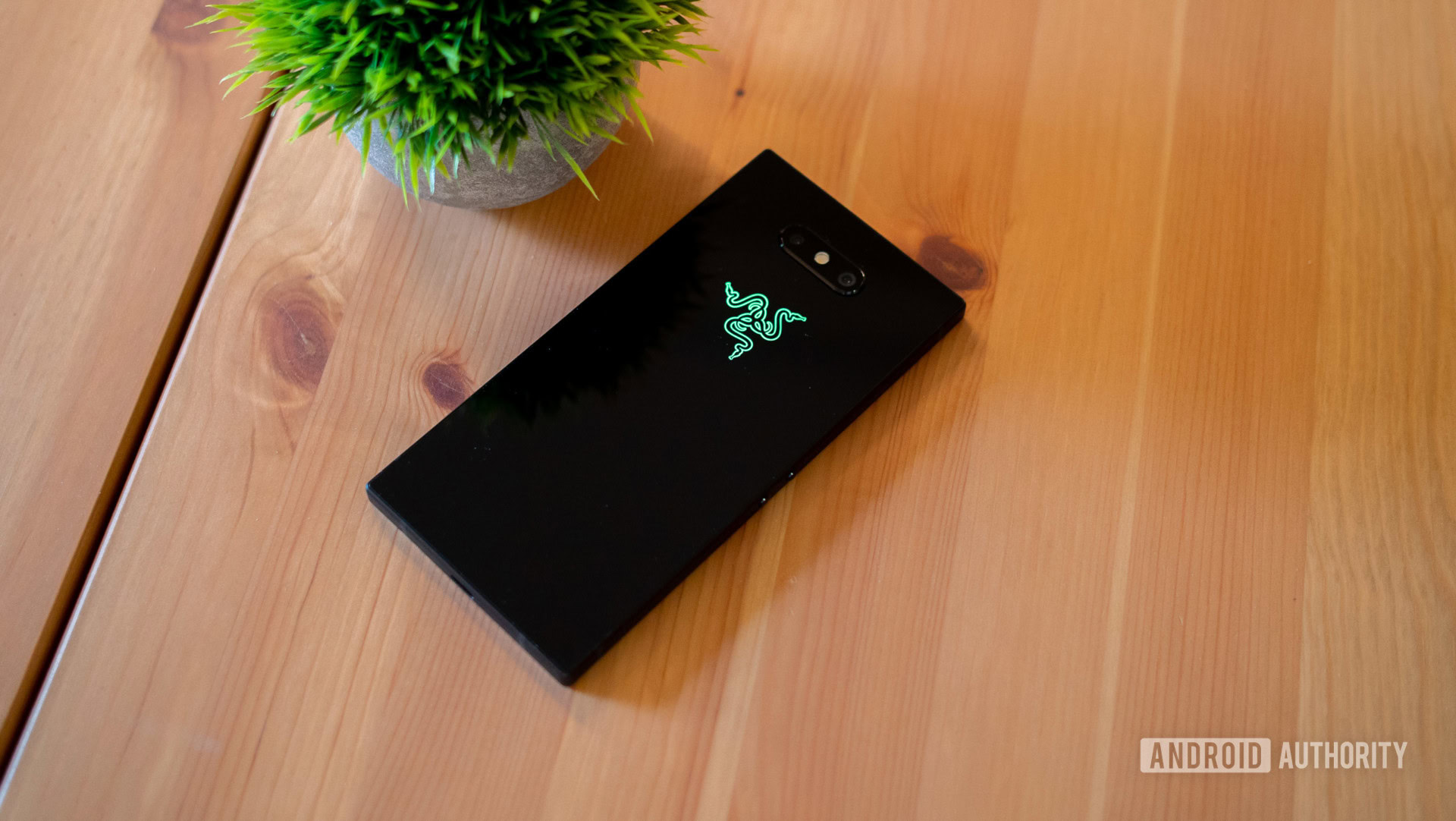
The Black Shark 2 is a good phone, not a great phone. It delivers hardcore performance in key metrics like battery life and raw power. Beyond that, the clean software, customizable light show, capable camera, and dedicated gaming experiences should entice those looking for a mobile BFG to tote into their next campaign.
If there’s anything holding it back, I’d say the huge and heavy chassis, lack of headphone jack, and limited LTE 4G support would be it.
The Black Shark 2 is probably the best buy for gamers who need more than the average flagship can deliver. Game on.